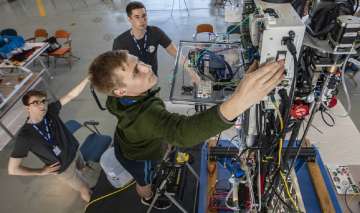NASA is giving university-level engineering students a unique opportunity to participate in the quest to harvest water on the Moon and Mars. The 2021 Moon to Mars Ice and Prospecting Challenge is asking eligible undergraduate and graduate student teams to design and build hardware that can identify, map, and drill through various subsurface layers, then extract water from an ice block in a simulated off-world testbed, the American space agency said.
Commenting further, NASA said the main goal of the team will be to harvest as much water as possible from simulated slices of lunar and Martian surfaces.
Each team will also identify critical differences between operations on Earth versus the Moon and Mars, and describe essential modifications needed for each in this "path-to-flight" description for their prototypes.
"The water we'll find when the next men and first women explore the lunar surface for the Artemis program is liable to be mixed with contaminants that need to be removed before drinking, or use as fuel," said Douglas Terrier, NASA chief technologist.
"Learning how to safely and efficiently prospect for and harvest water is key for sustainable human exploration – not only on the Moon but also on Mars and at other far reaches of our solar system," he added.
How to apply for NASA's 2021 Moon to Mars Ice and Prospecting Challenge
Interested teams must submit a project plan detailing their proposed concept design and operations. The last date to submit the application is November 24, 2020.
Up to 10 teams will be selected in December to receive a $10,000 development stipend to build and test their systems over the next six months before demonstrating their capabilities in a three-day competition at NASA’s Langley Research Center in Hampton, Virginia, next June.
Officials may award travel stipends to top-performing teams to present their design at a future NASA-chosen event or aerospace conference.
NASA's 2021 Moon to Mars Ice and Prospecting Challenge: The Relevance
Water is essential for extended lunar and Mars expeditions, whether astronauts drink it, grow plants with it, or make rocket propellant from it. But water is also heavy and expensive to bring from Earth. The good news is that in the past decade or so, scientists learned that water is more abundant in our solar system than previously thought, and we’re sending a water-mapping rover there to learn more, NASA said.
“The Artemis program is inspiring the brightest minds in academia, and it is important for us to provide those talented students with unique, hands-on opportunities to contribute to the future of human space exploration,” said Dr. Prasun Desai, deputy associate administrator of NASA’s Space Technology Mission Directorate (STMD).
“We look forward to seeing their technological breakthroughs as they progress through the competition.”
Also Read | NASA releases new photo showing shape of bubble surrounding our solar system
